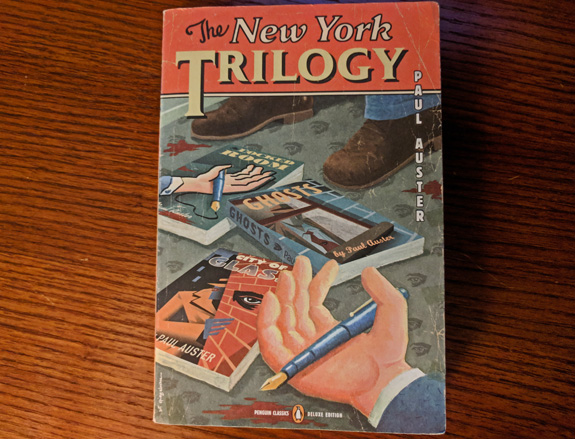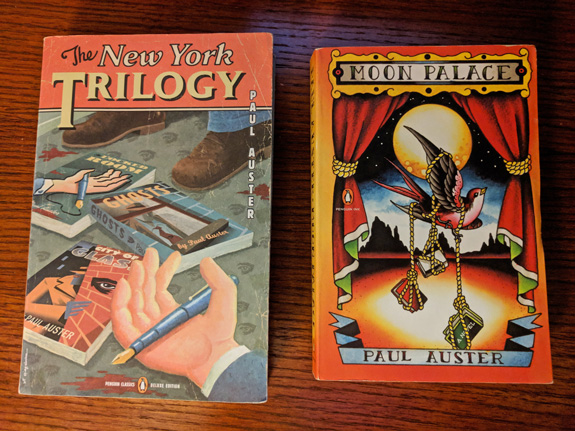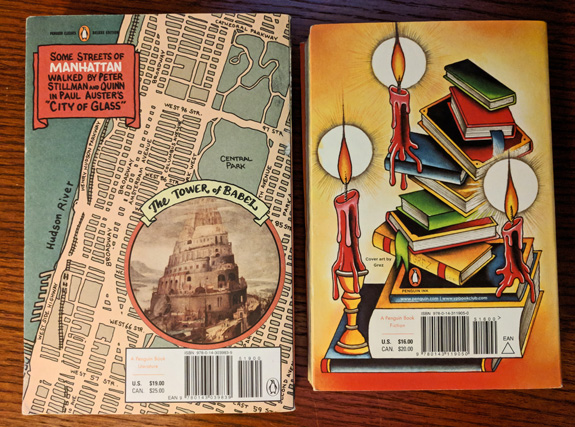Let’s take a moment, breathe in, breathe out, and stop to appreciate the beauty of actual, real-life printed books.
Sure, I’ve read my share of e-books and mass-market print editions that don’t do a ton with design. But then I’ll walk into a bookstore in New York City, browse a shelf and come across the name of an author I really like and find a book of his I haven’t read in a truly awesome form. I’m talking vibrant colors(!!!) on the cover with evocative images that wrap all the way around the back.
“The New York Trilogy” is not the first of Paul Auster’s books like this I’ve had no choice but to bring home. A few years ago I read “Moon Palace” in a similar style, and even while purchasing the second one I was under the impression they were done by the same artist.
Side-by-side it’s clear the styles are so different they would be unlikely to come from the same hand — Art Spiegelman on the left, Grez on the right. But that didn’t stop me from feeling all smart when I was at the counter at the bookstore in Chelsea Market and the guy helping me touted the beauty of “the Spiegelman art.” I acted in the know even though it turned out I wasn’t at all.
I talked about this when I wrote about “Moon Palace,” but I can’t possibly appreciate the deckle edge page style these books any more.
I mean can all books just be like this?
“The New York Trilogy,” as you may guess, is really three stories — City of Glass, Ghosts and The Locked Room — and also as you may guess they take place in … New York! We all had the appropriate amount of caffeine today.
When you open the front cover there is the usual page of blurbs from various reviews of the book, the first of which is from The Village Voice saying Auster has turned “the mystery novel inside out.” I never stop to read all of those just in case there might be the slightest inkling of a spoiler in there, but I did notice that one and thought about it a lot throughout the book.
These are all mystery stories with a sort of detective involved, and yet it’s not the Raymond Chandler-esque setup of someone walking into Marlowe’s office with a problem that needs solving. It’s not about a tough detective or a too-smart private eye outwitting everyone as the pieces come together in a big mystery.
Instead, these are three stories where the person trying to figure everything out is trying to figure everything out. That includes not only specific facts, but even more so their own motivations. What am I even doing? What am I supposed to be doing? Why am I doing this? Those are the questions that pervade the entire string of stories.
The first story involves a guy who gets a random phone call at night looking for a detective. But he’s not one. It’s his house. He gets more of these calls and eventually figures that even though he’s a writer, what the heck? I’ll try to help these folks.
The second story is I think the most fascinating. A detective by the name of Blue is hired by a guy named White who tells him nothing about his assignment. Just go to this apartment and watch a guy named Black. Report back by letter and get a check in the mail. It’s a slow-burn psychological story that absolutely makes you want to put together the pieces of what is happening, but like Blue, you don’t even know what you’re working with and what is just everyday noise of life.
“Of Black, of White, of the job he has been hired to do, Blue now begins to advance certain theories. More than just helping to pass the time, he discovers that making up stories can be a pleasure in itself,” Auster writes.
“Murder plots, for instance, and kidnapping schemes for giant ransoms. As the days go on, Blue realizes there is no end to the stories he can tell. For Black is no more than a kind of blankness, a hole in the texture of things, and one story can fill this hole as well as any other.”
I have tremendous thanks for the friend who long ago recommended an Auster book to me. I have enjoyed so many of them and can happily suggest you do so too.



